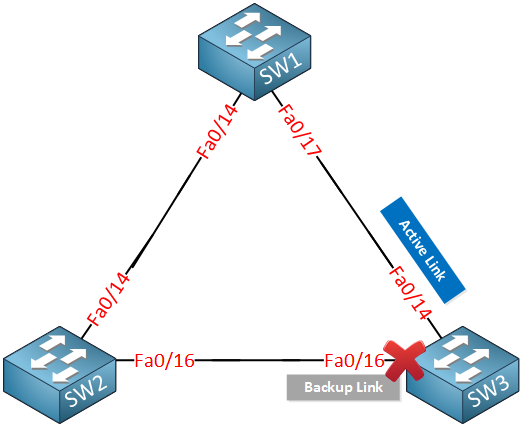When you have a redundant switched topology, spanning tree will block some of the interfaces to create a loop-free topology. Another method to deal with redundant topologies is by using Flex Links . When you configure Flex Links, you’ll have an active and standby interface. Here’s an example:

In the topology above spanning tree would block one of the interfaces to create that loop-free topology. This time, however we are going to use Flex Links. What happens is that one interface will be the active link, and the other one will be a backup link. The backup link is down and only comes up when the active link fails.
I can configure this on SW3:
- Fa0/14 will be the active interface.
- Fa0/16 will be the backup interface (this one is blocked!).
When you configure interfaces as Flex Links, they will not send BPDUs. There is no way to detect loops because we don’t run spanning tree on them. Whenever our active interface fails, the backup interface will take over.
Let’s look at the configuration…
Configuration
I will configure SW3 so that interface Fa0/14 is the active interface and Fa0/16 becomes a backup:
SW3(config)#interface fa0/14
SW3(config-if)#switchport backup interface fa0/16This is how we make interface fa0/16 a backup of interface fa0/14. You’ll see this message on the console:
SW3#
%SPANTREE-6-PORTDEL_ALL_VLANS: FastEthernet0/14 deleted from all Vlans
%SPANTREE-6-PORTDEL_ALL_VLANS: FastEthernet0/16 deleted from all VlansSpanning tree is being disabled for these interfaces. Let’s verify our work:



Rene,
Hi. In a normal working state, what does the interface status look like if one were to say issue a “show interface status” or “show interface F0/16” in this case?
Many thanks.
Thomas
Hi Thomas,
It should show something like “standby mode” line protocol down instead of up/up.
Rene
is there any reason to run flexlink rather than STP?
I think the only advantage is the convergence time, flexlinks are faster than RSTP.
Hi Rene,
Can you explain what if failed link get backup, will it automatically switch over to active link.?